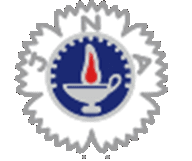- ホーム
- Japanese Nursing Association
- JNA Activities
- COVID-19 in Japan
COVID-19 in Japan
VOL.1 Patients dying alone: The dilemma between infection control and medical ethics
In April 2020, when Coronavirus disease (COVID-19) had its first rapid spread in Japan, nurses at hospitals caring COVID-19 patients faced both tough working conditions and issues with medical ethics. This is the story of the nurses’ ethical conflicts associated with COVID-19, but found solutions to some of their challenges.
Kawasaki Municipal Tama Hospital is located in the northern part of Kawasaki City in Kanagawa Prefecture, and is classified as a core hospital responsible for acute medical care in that area. It has been accepting COVID-19 patients with moderate symptoms.
At its peak of COVID-19 outbreak in April and May, some elderly patients with dementia were admitted to the hospital as well as those with intellectual disabilities, the frontline situation became quite severe. At that time, Yoshiko Sato, Deputy Director of hospital and Director of Nursing, saw the nurses struggling between medical ethics and infection control.
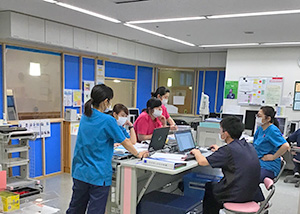
A meeting in the infection ward:
Zoning of the area behind the blue wall is
a red zone with infected people
Ms. Sato explains, "To minimize the nurses' exposure time, I instructed them to try not to be in the red zone with infected people for more than one hour at a time. But the nurses were not able to leave their patients' sides as everything just took time. They couldn't feel a patient's pulse because multiple layers of gloves blocked the sense of touch in their hands. They couldn't get too close to a patient's face to read their expressions, or hear what they were saying. They had a really hard time as they could not care for their patients as a nursing professional should."
In April, the nurses' dilemma came to a head. One elderly patient who had transferred from another hospital passed away.
Since that patient had requested no life-sustaining treatments, the hospital was tasked with end-of-life care for the patient without any further advanced medical care even if the disease became critical. We had a procedure manual for end-of-life care for COVID-19 patients, but the nurses said that some of the contents were not ethically acceptable.
Ms. Sato says, "End-of-life care in normal times involves staying close to patient’s heart and understanding to their every need as well as providing grief care for families. That process is simply ingrained in our staff, but with COVID-19 patients, they were not able to do so. Some nurses even spoke out, saying 'this is not real end-of-life care?!'"
In addition, nurses felt difficulty that the patient frequently removed his ECG monitor and oxygen mask. Then, the patient had to be physically restrained, and he died in his restraints. The nurses normally try to avoid using physical restraints, so that was a huge shock for them. At the death conference (debriefing) held 10 days after the patient's death, many nurses expressed their heartbreak. Some nurses even shed tears and said, "What is nursing?"
Ms. Maki Fujii, the Certified Nurse Specialist in Family Health Nursing*1, who was working to support the nurses, listened to their complaints at the death conference, and suggested that nurses should share not only the things they couldn't do, but also the things they did for patients, or what went well. There were then such comments as, "I was able to show the patient an email from his grandchild" or "I was able to talk with his family." More positive comments were heard, such as solutions including "finding what I can do in these tough times" or "thinking about what I might be able to do next time."
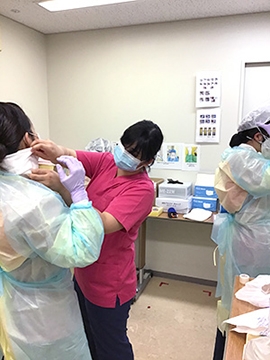
PPE checks were carried out in pairs
Ms. Fujii and the nurses began a discussion about what they could do if they were ever in the same situation again, such as enabling conversations between patients and families when they couldn't see each other directly, including conversations through the wall or using information and communication technology.
They also launched weekly “Sharing meetings” which enabled regular communication among staff members. This led to a dramatic improvement in team morale in the infection ward.
In parallel with these efforts, Ms. Sato made a proposal at the hospital's COVID-19 Task Force, to create an ethical guidelines for healthcare professionals in the hospital as a whole.
As a result, the new Ethical Guidelines for Treatment of COVID-19 Patients was compiled, based on the Four Principles of Health Care Ethics, and set out the hospital's position under the eight points. Today, with no end in sight to COVID-19, the nurses continue their work while facing the difficult balance between infection control and medical ethics.
(Last updated: Aug. 2020)
- 1 Certified Nurse Specialist in Family Health Nursing:These specialists undergo specialist nursing training ata graduate school, and then pass the credentialingexamination given by JNA. They take on the principalroles of managing relationships between patients,families and medical professionals, providing grief carefor families and helping patients and their familiesimprove self-care and empowerment.
See the following website for more information about Certified Nurse Specialists:
VOL.2 Efforts of Public Health Nurses responding to COVID-19
The Japanese Government specified COVID-19 as a Designated Infectious Disease in February 2020 and established countermeasures including hospitalization for patients, the provision of publicly funding healthcare, and surveys on the incidence of infections, the trends and their causes. Public Health Centers had a central role in this response, as did the nurses working there, namely Public Health Nurses※1. There are 469 government-run Health Centers※2 in Japan, with around 8,000 Public Health Nurses. In this article, we will introduce the work of the Public Health Nurses at the Tama District Health Center in Tokyo, where the highest number of COVID-19 infections was marked in Japan.
The Tokyo Minamitama Health Center is one of five health centers in the Tama District of Tokyo. It has around 424,000 people under its jurisdiction of the public health administration. There are 67 people working at the center, including 20 Public Health Nurses, only three of whom are responsible for infection control.
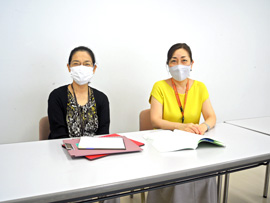
Ms. Murai and Section Head Akane Kasai
As with Health Centers throughout the country, Minamitama Health Center has followed the instructions of the government and set up a 'Returnees and Close Contacts Consultation Center' as a centralized point of contact for COVID-19 enquiries from city residents. However, as Section Head Akane Kasai explains, "from the end of March when infections in Tokyo began to sharply increase, all of our services were overwhelmed and the Public Health Nurses worked all week long until late at night to cope with the demand."
In reality, the work that Public Health Nurses perform in relation to COVID-19 covers many areas. According to Ms. Kasai, Public Health Nurses at Minamitama Health Center provides support for a person with suspected or infected COVID-19, follows the steps below (as of July 2020).
First, the following support is given to the person suspected COVID-19.
- Triage via telephone at the 'Returnees and Close Contacts Consultation Center'
- Coordination/support/transport for consultation at the Returnees and Close Contacts Outpatient Center
- Coordination for PCR testing, specimen collection of the PCR test carried out at a hospital/clinic, and specimen transport to the health & safety research center.
If the test result is positive, once a physician-issued 'Incidence Notification of Novel Coronavirus Infection' is received, the following steps are taken.
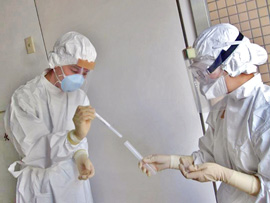
A specimen taken by a doctor is wrapped
in 3 layers by a Public Health Nurse and
taken to the lab
- Coordination/transport to hospital for admission
- Active epidemiology survey (the patient and facilities)
- Support/consultation for those under home isolation for specific reasons
- Transport for inpatients transferring hospitals if the infection becomes more serious
- Contact at the time of discharge, and perform the PCR test to confirm negative test result for patients under home isolation (until late May)
- Sterilization orders sent to the relevant facilities based on the active epidemiology survey for positive cases
- Handling of various queries from facilities in preparation for a positive case being identified
- Identification of close contacts, contacting those people and requesting their nearest Health Center for a health check-up and PCR test
- Treatment consultations and health check-ups for close contacts, and from May 29, PCR tests for all close contacts in line with government instructions
In addition to the above, the work of Public Health Nurses also involves the following: liaison and coordination with relevant organizations and other Health Centers, writing reports to send to government/Tokyo Metropolitan authorities, and, if requested by Quarantine Stations, health check-ups for overseas returnees from areas where COVID-19 is prevalent.
Public Health Nurse Yasuko Murai says that as part of the whole process of treatment and support, Public Health Nurses make great efforts to protect and support infected individuals and their close contacts against prejudice and mental abuse.
Here is one example of the type of incidence that has occurred. When visiting the home of suspected infection to take a sample for a PCR test, while it is essential for Public Health Center staff to wear Personal Protective Equipment (PPE) to prevent infection, this created a problem.
Ms. Murai explains, "There are many residents who do not want their neighbors knowing they are infected. If rumors of an infection spread, they may no longer be able to live in their community, and they may even have to move or change jobs. So, we can't enter their homes wearing our white gear (PPE)."
After some trial and error, residents needing tests were asked to meet at places such as local parks or under bridges away from prying eyes, and the Health Center physician would collect the specimen from them while in their car.
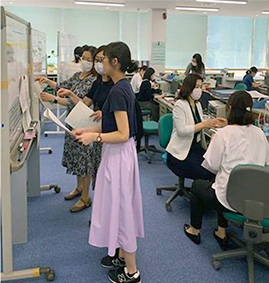
Public Health Nurses busy handling
arrangements for residents
Ms. Murai says, "We waited in our car with our PPE gear on, and the individual would come to the outside of the car. There was less infection risk for us, and it did not attract the attention of neighbors. Time-wise, this was also the most efficient."
Public Health Nurses also have an important role in preventing prejudice and mental abuse in these sorts of communities. As the most accessible public health providers for people living in the community, Public Health Nurses continue their work in the midst of COVID-19 to protect the health of the people.
(Last updated Sep.2020)
-
1. Public Health Nurses:
'Public Health Nurse' means a person licensed by the Minister of Health, Labour and Welfare to use the title of Public Health Nurse and provide health guidance as a profession. (Act on Public Health Nurses, Midwives, and Nurses, Article 2)
Public Health Nurses work at government facilities including Health Centers and city/town/village offices, as well as in industry and hospital locations. Those working at city/town/village offices have been on an increasing trend every year. A 2016 survey of work locations showed that the proportion was 58.5% at Health Centers and city/town/village offices, 25.8% at hospitals or clinics, and 5.0% at places of business.
Public Health Nurses, who are responsible for public health and nursing activities, are specialists who have continued to preserve their district nursing work that involves health and nursing in the community. These activities have enabled the discovery of health problems common to their communities, and they are positioned as professionals whose work involves exploring paths to solutions, while placing importance on creating partnerships and collaborating with residents. The work of Public Health Nurses is relied upon for solutions to more diversified and complex health issues, and in recent years in particular, their role has been even more necessary to respond to urgent and difficult issues such as lifestyle diseases and suicide prevention, a need that is continuing to rise. -
2. Health Center:
These centers are run by national or local government bodies for the purpose of maintaining and enhancing the health of local residents. Health Centers and city/town/village health centers have been set up by local governmental bodies throughout Japan in accordance with the Community Health Act.
A Health Center, as a broad, specialist and technical base for disease prevention and improving health, refers to the service in which support is given for the health of local residents. They are established in prefectures, designated cities, core cities and special administrative districts (wards).
City/town/village health centers provide a general level of service directly to local residents, including health consultations, health guidance and health check-ups.
VOL.3 An elderly care facility fighting COVID-19 with thorough infection control
The Geriatric Health Services Facility※1 "Yukari Yutoen" is located near Tokyo, in Sakura City, Chiba Prefecture. Catering to 96 residents and 25 day care rehabilitation patients, staff members include one doctor, 12 nurses (incl. four part-timers), 50 care workers and 5 PT/OT staff. Following the spread of the Coronavirus disease (COVID-19), thorough infection control measures were put in place, and as of November 2020, there have been no COVID-19 cases among the residents or staff.
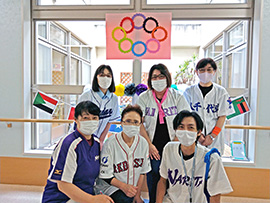
The nurses at Yukari Yutoen:
Nursing and Care Director Fujiko Maeda
is at center, bottom
Fujiko Maeda, the Nursing and Care Director, has worked hard to take infection control initiatives since her appointment two and a half years ago, given that such control is essential on a daily basis for elderly group homes/facilities. With the basics of standard precautions and transmission-based precautions, thorough measures were taken including having all nurses and care workers carry their own hand sanitizer with a policy of 'one care, one hand-wash (or hand sanitize)'. There were also appropriate procedures established for disposal of bodily excrement and contaminants, as well as efforts made toward the early detection and treatment of abnormalities in facility users. The nurse became Infection Control Committee Leader and carried out regular checks for handwashing and correct use of PPE (Personal Protective Equipment). November to March is the period when influenza is most prevalent, and this became the 'Enhanced Infection Control Period' in which all staff had their temperatures checked and were required to wear masks upon arrival at work, and humidifiers were used in the facility. In addition, an infection specialist was invited twice a year from a university hospital or other facility to give lectures designed to raise the awareness of the entire staff, including those in administration.
In late March when there was a rise in COVID-19 cases in Chiba Prefecture, control measures at Yutoen were intensified. Unnecessary and non-urgent outings by residents were banned, family visits were forbidden, on-site visits by external maintenance staff/service staff to the facility were kept to a bare minimum and medical consultations for residents were only allowed in an emergency.
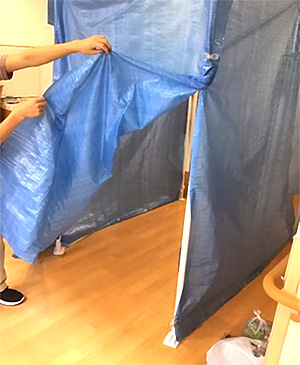
PPE were put on and removed in an 'anterior
compartment' created from blue sheets
In addition to infection control measures, the nurses at Yutoen put effort into the handling of residents with fever. It is not uncommon for elderly persons accompanying chronic diseases to experience unexplained fevers. It was anticipated that it would be difficult to differentiate these fevers from those caused by COVID-19, that local hospitals may not accept patients from Yutoen, and that it could be difficult to get a PCR test.
Ms. Maeda explains: "The elderly often experience unexplained fevers, so we created a flow chart for differentiation from COVID-19." If the patient has a fever or cough, even if infection cannot be confirmed, he or she would be placed in a private room for observation, and infection control intensified. If the fever were high, they would be tested for influenza. In addition, treatment following the facility's 'Pneumonia Manual' was commenced, and blood tests were taken to check CRP values and a white blood cell picture.
They also simulated the procedures to be taken if a resident was infected with COVID-19. Ms. Maeda continues: "Even if a PCR test is positive, the hospitals won't take the patients immediately. We knew we had to care for them ourselves for a time, so there was a need to put systems in place". All of the rooms at Yutoen are private with each door opening straight into the living room, so there was no place to put on or remove PPE. They therefore created a small 'anterior compartment' out of blue sheets outside each room. They ordered N95 masks and caps, and created a procedure whereby nurses would put on and remove their PPE in this space. By simulating the actual procedure, staff were able to be ready to deal with infected patients anytime."
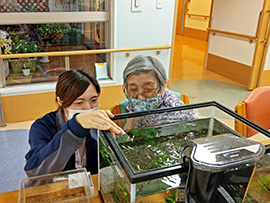
A resident with a care staff
With these control measures in place, for the sake of the residents' mental health, through-window visits and remote meetings with family members were conducted. Remote meetings enabled residents to see family members who lived far away and had not previously been able to visit them, and this was something they felt they could use in the future as well. They continue to prevent the build-up of stress among residents, with staff taking them into the facility's garden more frequently, among other measures. As Ms. Maeda says, "What we have realized, through strengthening these infection control measures, is that maintaining social distance in elderly care settings is difficult. The optimal mental health care for them includes touching, being next to them and listening. We would, as much as possible, like to continue to place importance on interaction with the residents as well."
(Last updated:Nov.2020)
-
Geriatric Health Services Facility:
A rehabilitation facility for the elderly needing long-term care to assist them to return home.
We would like to hear your feedback about our website.

